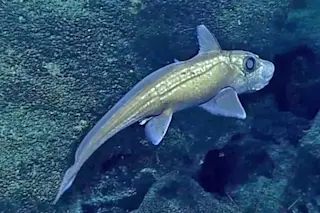Image courtesy of the NOAA Office of Ocean Exploration and Research, 2016 Deepwater Exploration of the Marianas.
Image courtesy of NOAA Office of Ocean Exploration and Research, 2016 Deepwater Exploration of the Mariana
Image courtesy of the NOAA Office of Ocean Exploration and Research, 2016 Deepwater Exploration of the Marianas
Image courtesy of the NOAA Office of Ocean Exploration and Research, 2016 Deepwater Exploration of the Marianas
Image courtesy of the NOAA Office of Ocean Exploration and Research, 2016 Deepwater Exploration of the Marianas
Traveling HomeA sea anemone is at home on top of a hermit crab. The anemone secretes a shell of sorts for the crab, which it then inhabits instead of a shell.The symbiotic relationship between anemones and other species of hermit crabs that rely on shells for protection is well documented. Crabs that outgrow their shells will often transfer the anemone from the old shell to the ...














